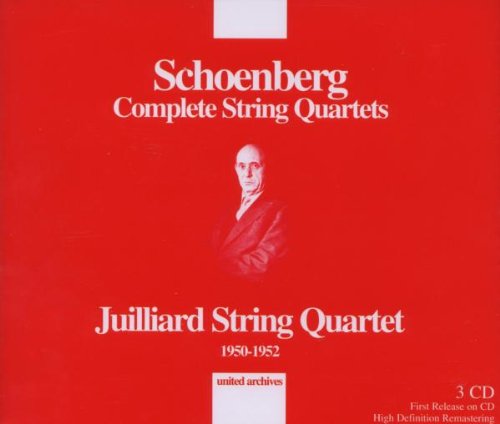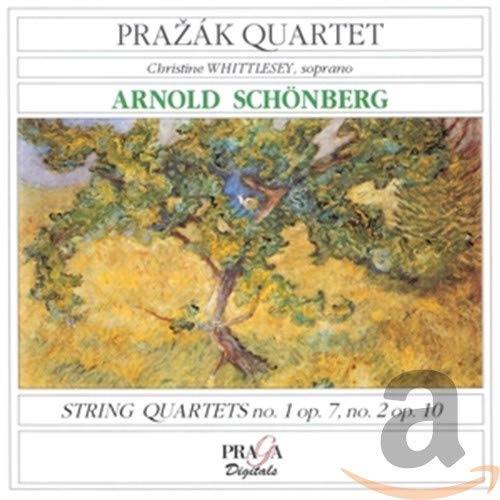The Austrian composer Arnold Schoenberg published four string quartets, distributed over his lifetime: String Quartet No. 1 in D minor, Opus 7 (1905), String Quartet No. 2 in F♯ minor, Op. 10 (1908), String Quartet No. 3, Op. 30 (1927), and the String Quartet No. 4, Op. 37 (1936).
In addition to these, he wrote several other works for string quartet which were not published. The most notable was his early String Quartet in D major (1897). There was also a Presto in C major (c. 1895), a Scherzo in F major (1897), and later a Four-part Mirror Canon in A major (c. 1933). Finally, several string quartets exist in fragmentary form. These include String Quartet in F major (before 1897), String Quartet in D minor (1904), String Quartet in C major (after 1904), String Quartet Movement (1926), String Quartet (1926), String Quartet in C major (after 1927) and String Quartet No. 5 (1949).
Schoenberg also wrote a Concerto for String Quartet and Orchestra in B♭ major (1933): a recomposition of a work by the Baroque composer George Frideric Handel.
String Quartet in D major
This string quartet in four movements is Schoenberg's earliest extant work of large scale: average duration of recorded performances is about 27 minutes. Completed in 1897, it was premiered privately on March 17, 1898, and publicly later that same year on December 20 in Vienna. It was published posthumously in 1966 (Faber Music, London).
Schoenberg's friend Alexander von Zemlinsky gave him much advice and criticism during the composition of this work. Zemlinsky even showed an early draft of it to Johannes Brahms, whom Schoenberg very much admired. It was given the old master's approval.
The string quartet is in four movements:
The original second movement was the Scherzo in F which now exists as a separate piece. Schoenberg substituted the Intermezzo at Zemlinsky's suggestion.
String Quartet No. 1, Op. 7
A large work consisting of one movement which lasts longer than 45 minutes, Schoenberg's First String Quartet established his reputation as a composer. Begun in the summer of 1904 and completed in September 1905, the quartet is remarkable for its density of its orchestration.
Unlike his later atonal works, the quartet is in D minor. The tonality is stretched to the limit as was common in late Romantic music. It also carries a small collection of themes which appear repeatedly in many guises. Instead of balanced phrase structures typical of string quartet writing up to that period, Schoenberg wrote asymmetrical phrases that build into larger cohesive groups.
According to Schoenberg, when he showed the score to Gustav Mahler, the composer exclaimed: "I have conducted the most difficult scores of Wagner; I have written complicated music myself in scores of up to thirty staves and more; yet here is a score of not more than four staves, and I am unable to read them."
String Quartet No. 2, Op. 10
This work in four movements was written during a very emotional time in Schoenberg's life. Though it bears the dedication "to my wife", it was written during Mathilde Schoenberg's affair with their friend and neighbour, artist Richard Gerstl, in 1908. It was first performed by the Rosé Quartet and the soprano Marie Gutheil-Schoder.
The second movement quotes the Viennese folk song, "O du lieber Augustin". The third and fourth movements are quite unusual for a string quartet, as they also include a soprano singer, using poetry written by Stefan George. On setting George, Schoenberg himself later wrote, "I was inspired by poems of Stefan George, the German poet, to compose music to some of his poems and, surprisingly, without any expectation on my part, these songs showed a style quite different from everything I had written before. … New sounds were produced, a new kind of melody appeared, a new approach to expression of moods and characters was discovered."
The string quartet is in four movements:
Text
The latter two movements of the Second String Quartet are set to poems from Stefan George's collection Der siebente Ring (The Seventh Ring), which was published in 1907.
String Quartet No. 3, Op. 30
Schoenberg's Third String Quartet dates from 1927, after he had worked out the basic principles of his twelve-tone technique. Schoenberg had followed the "fundamental classicistic procedure" by modeling this work on Franz Schubert's String Quartet in A minor, Op. 29, without intending in any way to recall Schubert's composition. There is evidence that Schoenberg regarded his 12-tone sets—independent of rhythm and register—as motivic in the commonly understood sense, and this has been demonstrated with particular reference to the second movement of this quartet.
The piece was commissioned by Elizabeth Sprague Coolidge on March 2, 1927, though the work had already been completed by this time, and its première was given in Vienna on September 19, 1927, by the Kolisch Quartet.
The string quartet is in four movements:
String Quartet No. 4, Op. 37
The Fourth String Quartet of 1936 is very much representative of Schoenberg's late style. Like the Third Quartet, this quartet was commissioned by Mrs. Coolidge. The slow movement opens with a long unison recitative in all four instruments while the finale has the character of a march, similar to the last movement of Schoenberg's Violin Concerto written about the same time.
The string quartet is in four movements:
References
Further reading
- Babbitt, Milton. 2003. The Collected Essays of Milton Babbitt, edited by Stephen Peles, with Stephen Dembski, Andrew Mead, and Joseph N. Straus. Princeton and Oxford: Princeton University Press. ISBN 0-691-08966-3
- Barbier, Pierre E. 1997. String Quartets nos. 1, 2, "Historical Legitimacy", included booklet. Praga Digitals PRD 250 112 HMCD 90. Prague.
- Burkholder, J. Peter. 1999. "Schoenberg the Reactionary". In Schoenberg and his World, edited by Walter Frisch, . Princeton University Press. ISBN 0-691-04861-4
- Frisch, Walter (Summer 1988). "Thematic Form and the Genesis of Schoenberg's D-Minor Quartet, Opus 7". The Journal of the American Musicological Society. 41 (2): 289–314. doi:10.2307/831435. JSTOR 831435. S2CID 194093809.
- Harrison, Max. 1999. Schoenberg, the String Quartets, in booklet for "Four Staging Posts on Schoenberg's Musical Journey". Phillips Classics 464 046-2. Munich.
- Rauchhaupt, Ursula von, ed. (1971). Schoenberg, Berg, Webern: The String Quartets. A Documentary Study. Translated by Eugene Hartzell. Hamburg: Deutsche Grammophon. pp. 9–80.
- Roy, Adam J. 2021. "Motivic Metamorphosis: Modelling Intervallic Transformations in Schoenberg’s Early Works". PhD Dissertation. Western University.
- Schoenberg, Arnold. 1997. String Quartets nos. 1 and 2. Mineola, New York: Dover Publications, Inc. ISBN 0-486-29693-8
- Stolz, Nolan. 2008. "Contrapuntal Techniques in Schoenberg's Fourth String Quartet". Eunomios (August): 1–10.
External links
- "String Quartet in D major (1897)". Arnold Schönberg Center.
- Matthias Schmidt. "String Quartet No. 1". Arnold Schönberg Center.
- Therese Muxeneder. "String Quartet No. 2". Arnold Schönberg Center.
- Camille Crittenden. "String Quartet No. 3". Arnold Schönberg Center.
- Mirjam Schlemmer. "String Quartet No. 4". Arnold Schönberg Center.
- String Quartet No. 1, Op. 7, String Quartet No. 2, Op. 10, String Quartet No. 3, Op. 30, String Quartet No. 4, Op. 37: Scores at the International Music Score Library Project




